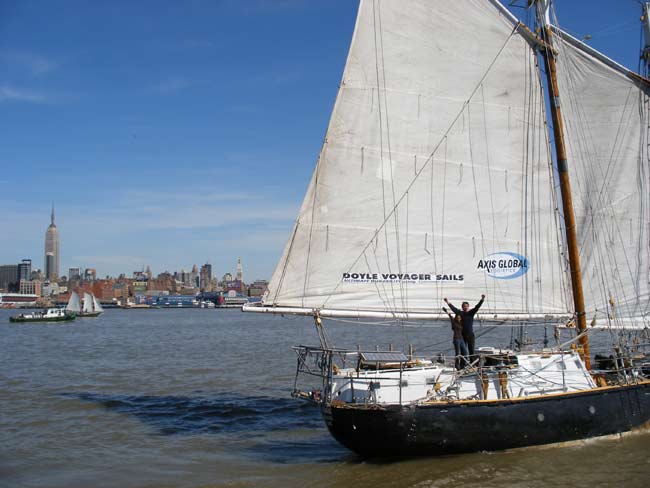Sailing Duo Begin 1,000-Day Ocean Voyage

HOBOKEN, N.J -- Two sailors cast off on the first of 1,000 planned days at sea Saturday in a bid to set a new world record.
Captain Reid Stowe and crewmate Soanya Ahmad set sail aboard the Schooner Anne, a 70-foot gaff-rigged vessel designed with long-duration voyages in mind, from Pier 12 here as more than 100 friends, family members and supporters cheered them on.
“Everything is stowed, we are ready,” Stowe told LiveScience from the deck of the Schooner Anne before setting sail.
Stowe and Ahmad are hoping to spend about 1,000 days, or nearly three years, beyond the sight of land in an attempt to break the current record ocean voyage of 657 days set by Australia’s Jon Sanders, who circumnavigated the globe three times between 1986 and 1988 to make the trip.
But Stowe’s expedition is one-part record seeker, and one part personal quest, which the veteran seafarer and artist has spent years planning. He’s billed the project, which is expected to run twice as long as Russia’s 500-day mock Mars mission, as “The Mars Ocean Odyssey” because of similarities between the trip’s anticipated isolation and self reliance to the more than two-year plans for red planet expeditions.
“The main area is psychology,” Stowe said, adding that even if his expedition fails he hopes to learn some lessons about the rigors of long-duration exploration that may prove useful for spaceflight researchers.
By coincidence, Stowe and Ahmad sailed down the Hudson River here towards the Atlantic Ocean less than seven hours after two professional astronauts and one U.S. tourist returned to Earth from the International Space Station. One of the spaceflyers, NASA astronaut and space station commander Michael Lopez-Alegria, set a new U.S. spaceflight endurance record after spending 215 continuous days in Earth orbit.
Sign up for the Live Science daily newsletter now
Get the world’s most fascinating discoveries delivered straight to your inbox.
It was the similarities to a manned spaceflight that drew the interest of Darr Palmer, one of Stowe’s sponsors whose firm manufactures hull material used in the Schooner Anne.
“It’ll be a test of human endurance and personal compatibility,” Palmer said in an interview.
While Stowe is a veteran sailor, Ahmad joined his crew just over one year ago. The Queens, New York native is the official photographer and videographer for the 1,000-day expedition’s Web site: 1000days.net.
“I think it would be a very beautiful experience, being out on the ocean,” Ahmad said in an interview.
After a year living and working on the Schooner Anne at a relatively isolated Hoboken dock, Ahmad said she believes she and Stowe are well prepared for their long-duration expedition.
Ocean challenges
After entering the North Atlantic Ocean, the Schooner Anne is expected to head south past the equator and then west towards the coast of Brazil. Stowe has said he and Ahmad plan to guide their ship on a heart-shaped pattern as an artistic statement.
During the trip, Stowe and Ahmad will not refuel their ship nor restock on food or other supplies, though Stowe does not anticipate any critical shortages.
“I’ve got all the supplies I need, and we’ve got really good communications equipment,” Stowe said before casting off. “We have more food than we need.”
Crammed into the cargo hold of the 60-ton Schooner Anne, a family-built ship named after Stowe’s mother, are 380 boxes -- each of which weighs 25 pounds -- of food donated by sponsors. Casks of fresh water, some 200 pounds of dried fruit, 500 pounds of rice and 400 pounds of cashews and almonds are also making the trip with Stowe and Ahmad.
The sailors are also carrying about 300 pounds of food-grade salt for use preserving fish caught at sea. They plan to start a small garden on deck for greenery and grow sprouts during the trip.
“It certainly is exciting,” Stowe’s mother Anne told LiveScience.
Solar panels and generators are built into the Schooner Anne to provide power. Stowe and Ahmad will also rely on a satellite phone and computer to stay in contact with a control team in New York as well as document their trip via their Web site.
“We’re going to do the best we can out there,” Stowe said just before casting off.

Tariq is the editor-in-chief of Live Science's sister site Space.com. He joined the team in 2001 as a staff writer, and later editor, focusing on human spaceflight, exploration and space science. Before joining Space.com, Tariq was a staff reporter for The Los Angeles Times, covering education and city beats in La Habra, Fullerton and Huntington Beach. He is also an Eagle Scout (yes, he has the Space Exploration merit badge) and went to Space Camp four times. He has journalism degrees from the University of Southern California and New York University.










